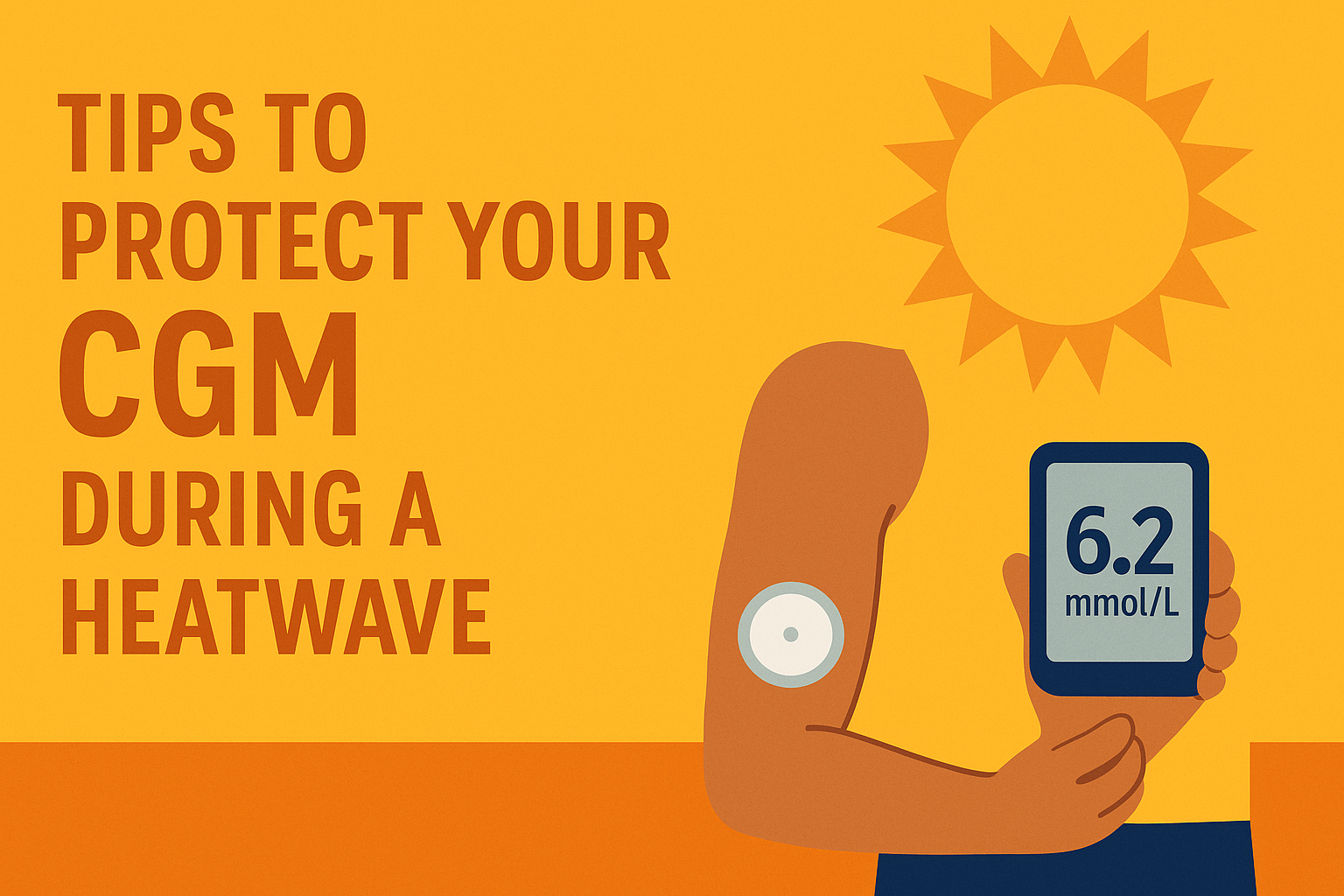This blog considers whether sensors can be worn for swimming and water activities and if so, are there any risks with prolonged immersion?
A NEW updated version of this article with more detail and tips is available in a Special Edition of Libre Life. Click here to go to FREE download.
💛💛💛
BELOW IS THE ORIGINAL BLOG - PLEASE DOWNLOAD ABOVE FOR LATEST INFORMATION
A frequent concern to sensor wearers is the issue of getting the sensor wet. Whether it’s in a hot tub, in a spa, in the sea, on water rides, playing water sports or any other water activity.
For example, the Freestyle Libre instructions state:
“Your sensor is water-resistant and can be worn while bathing, showering or swimming.
Do NOT take your Sensor deeper than 1 metre (3 feet) or immerse it in water for longer than 30 minutes. “
Here, we explain these limits and what your options are when participating in water activities.
💛💛💛
Are sensors waterproof?
Libre sensors are water-resistant to IP67 standard, but this isn’t waterproof. The two terms do not mean the same thing.
The manufacturer has only tested the sensor to the standard to meet this international rating. It confirms that the sensor is able to withstand being immersed in water under defined conditions of pressure and time i.e. to a depth of 1m for a period of 30 minutes. In addition, tests only give a level of water-resistance in pure water when the object is static.
This does not mean that sensors have been tested and determined as suitable for wearing in a swimming pool or the sea, when movement adds to the forces on the sensor. Heat from hot tubs or jacuzzies may also put different pressures on the sensor and adhesive which may also affect its ability to function correctly. These conditions have not been tested by the manufacturer.
In fact, there’s no such thing as ‘waterproof’ as all materials will be penetrable at some point - it’s just depends on the conditions.
NOTE: READERS ARE NOT WATER-RESISTANT OR WATERPROOF AT ALL AND SHOULD BE KEPT AWAY FROM WATER AT ALL TIMES.
What about pumps - are these waterproof?
Some pumps are described by their manufacturer as ‘watertight’ and this usually means that they can withstand rain and splashes, but are not suitable for submersion.
For example, Tandem pumps are watertight to IPX7 standard but are not suitable for wearing while showering, swimming or diving.
Some Medtronic pumps (MiniMed 630G & 770G) are waterproof with a IPX8 standard, to a limited depth and time and the tubeless Omnipod Dash has an IP68 rating for submersion up to 7.6m for 60 minutes.
Due to general wear and everyday bumps, all pumps can develop tiny cracks which may not be visible but which can make the pump susceptible to water damage. Swimmers should check the pump manufacturer’s instructions before exposure to water.
If you’re wearing a CGM with a 3rd party transmitter such as MiaoMiao, Blucon NightRider or Bubble, you may find that these are not suitable for immersion in water. As with pumps the plastic can develop cracks which compromise its waterproof rating.
💛💛💛
What could happen if I stay in the water for too long?
There are 2 main risks to a sensor if you exceed the 30 minutes or swim deeper than 1 metre.
Firstly there’s the adhesion of the sensor to the skin or where the sensor is attached to the sticky film itself. The first of these is the more likely issue for sensor wearers as the body has many contours that mean sensors are not lying completely flat on the skin and so if the glue weakens it could loosen the contact between skin and sensor.
Secondly the functionality of the sensor could be affected by prolonged immersion in water. This is less likely but this does happen in some instances.
If swimming in the sea, salt can affect the adhesion of a sensor (or sticker covering it)causing it to loosen or come off.
💛💛💛
What factors will affect the sensor in water?
One factor that may affect this is heat. So, whilst you can wear a sensor in a hot tub, prolonged time in the water may mean that the glue weakens and the sensor falls off.
Another problem that you may experience is when movement adds to the forces on the sensor. The viscosity of the water on the sensor may cause it to loosen or come off, for example when doing water sports or sliding down a water chute.
A third factor is the presence of chemicals in the water. As we’ve mentioned, the IP67 standard is where the product is tested in pure water so does not take into account the ‘real-world’ conditions we’re likely to encounter when swimming and other related activities.
Any activity that dries out the skin – like enjoying an evening in the hot tub - can affect the adhesion of a sensor!
Read also: Top 10 Tips for getting your Libre sensor to stick.
💛💛💛
Can I make it waterproof?
Many of us find the limitations set by the manufacturer as too restrictive and it’s a common question to ask “how can I make the sensor waterproof” so to be able to swim for longer or do other water activities.
There are an assortment of suggestions online to resolve the issue. Popular ideas are stickers, patches and plasters. However, covering a sensor with a sticker, patch or plaster will not make it waterproof or increase the waterproof rating stated by the manufacturer.
When covering a sensor with a sticker or patch it's likely that small amounts of water will get underneath and erode the adhesion between the sensor and the skin. It can also lead to skin irritation, not to mention the likelihood that the sticker or patch will start to peel and look unsightly. A sensor's functionality could also be affected by water 'trapped' under the sticker or patch and it may it stop giving accurate readings.
If a product tells you that it is waterproof and not just water-resistant, this would mean that the skin can't 'breathe'. The consequences of this could be that sweat from the skin's normal day to day activities cannot escape and this itself is likely to lead to other skin problems.
💛💛💛
What other options are there to protect the sensor when swimming?
Wearing a Libreband will help to protect a sensor from the friction caused by swimming and being in water, such as in a hot tub. The cover and neoprene armband are themselves water resistant. However, the product does not provide any additional waterproof protection to the Libre sensor as it's just not possible.
A key advantage to wearing a Libreband in water is that it can be put on and removed easily. This enables the skin to dry naturally and reduces the likelihood of adhesion problems. Librebands also dry quickly and can be worn again and again - in fact reused many times!
Many Libreband customers including competitive athletes, have worn the armband for swimming and water activities and have found it helpful for protection and in giving them confidence in water whilst wearing a sensor, especially when doing so for extended periods.
Librebands have been worn by customers in swimming pools, open water, hot tubs, spas and the sea.
Advantages of wearing a Libreband®
✅ Quick drying, water-resistant strap
✅ Protects against friction of water
✅ Soft neoprene fabric for comfortable, close fit
✅ Wear as and when needed
✅ Easy to put on and take off
✅ Durable for repeated wear with long lasting protection
✅ Doesn't fray, lift or get dirty at the edges like stickers
✅ Reduces likelihood of skin irritation compared to stickers.
Read also: How a Libreband provides better protection.
💛💛💛
What if I’m wearing a transmitter eg. MiaoMiao or Bubble?
If your wearing a 3rd party product ie. additional transmitter, with your sensor then you may need additional support when swimming or participating in water activities. Although most of these products advertise themselves as being waterproof, they may not conform to UK standards and you should be particularly cautious if purchasing such products 2nd hand.
Our Libreband+ range of armbands can help with keeping transmitters in position too.
Read also: About Libre sensor with MiaoMiao, Bubble and BluCon NightRider
💛💛💛
What else can I do?
In addition to wearing a Libreband, below are some steps we recommend when swimming wearing a sensor or CGM.
- When wearing a Libre sensor, it’s important to keep hydrated so that the body works as efficiently as possible and this is especially true when swimming and being active in water. To avoid the effects of dehydration you should keep up your water consumption, during activities and afterwards too. It’s a good idea to keep a bottle of water on the poolside for this reason.
- Rinse off immediately post-swim as this will reduce the effect or any chemicals from the water, or salt from the sea.
- Always moisturise as soon as you can after you have finished your activity, once rinsed-off and dry. This can help to keep moisture from evaporating and prevent the skin from drying out.
💛💛💛
Summary
Wearing a sensor for longer than the stipulated 30 minutes does mean that the sensor is not being used in accordance with the manufacturer’s instructions and could therefore invalidate the warranty. But, many wearers do swim for longer than 30 minutes and go deeper than 1 metre, without any problems, and this includes long distance swimmers and lifeguards too.
Although there are products available that advertise they are ‘waterproof’ it is more likely that they mean water-resistant and using a sticker or covering will not ‘waterproof’ the sensor itself. However, covering it such as with a Libreband may help to reduce the likelihood of it being knocked or falling off.
Below are some reviews we’ve received mentioning swimming with a Libreband.


💛💛💛
Further information
You can see our video on Swimming with a Libre Sensor here.
💛💛💛
Disclaimer
Love My Libre is not associated or affiliated with Abbott or FreeStyle Libre. Content here and on our website www.lovemylibre.com does not constitute medical advice or replace the relationship between you and healthcare professionals nor the advice you receive from them.
The author of this blog has type one diabetes and uses the FreeStyle Libre 2 which is provided on NHS prescription.
FreeStyle Libre is a registered trademark of Abbott Diabetes Care Inc.






Strath Clarke
October 25, 2023
Hi,
I’ve Scuba dived with my Libre Sensor without any issues afterwards.
Eight dives to 20 m depth and around 40 minutes per dive with the same sensor.
The sensor also survived donning and doffing (yep – that’s the word) my tight wetsuit.
Just need to work out a way of reading the sensor underwater.
Strath